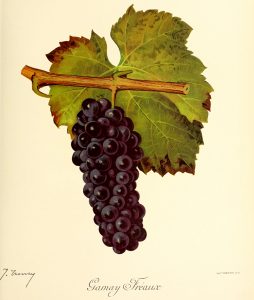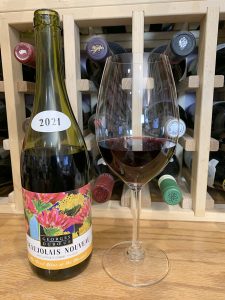Beaujolais is a lovely French region sandwiched between Burgundy and Lyon. Last century, it was known for its kitschy, flash-in-the-pan plonk—Beaujolais nouveau. Today, it is known for being the next big thing in quality wine. Such are vino’s vicissitudes.
Virtually all the 44,000 acres of Beaujolais vineyards are planted in gamay grapes. Gamay is a cross between pinot noir and gouais blanc, a progenitor of many varieties, including chardonnay. Gamay ripens two weeks earlier than pinot noir and is very vigorous. Those traits caused trouble in Burgundy. In 1395, the Duke of Burgundy Philippe the Bold outlawed gamay because it was a “very bad and disloyal plant.”
Gamay growers moved south into Beaujolais where authorities were less supercilious and welcomed folks who could produce large quantities of light bodied, fruity wines.

Gamay vines focus on making grapes rather than deepening roots, which means when stressed by lack of water gamay produces wines with high acidity. Acidity is a reason Beaujolis is the darling of food-pairing sommeliers. To tone down acidity, many Beaujolais wines are made using carbonic maceration where grapes ferment in a carbon dioxide-rich environment before crushing. Much of the juice ferments inside the grape.
The result is a very fruit-forward wine with low tannins that is easy to drink soon after it is made. That spawned the Beaujolais nouveau craze at the end of the 20th century. Beaujolais nouveau can be sold just six weeks after harvest—officially beginning on the third Thursday of November.

That marketing shenanigan clicked in the U.S. since it coincided with Thanksgiving. No hoity-toity hostess could pass up Beaujolais boasting at her dinner. In fact, minutes after release, some cases of Beaujolais nouveau were loaded on the Concorde to be whisked at supersonic speed to inflate the egos of New York City parvenus.
Of course this went the way of all fads. Growers over-produced. Consumers recoiled. In 2001, more than 1.1 million cases of Beaujolais—most of it nouveau—had to be destroyed. Scandals blossomed—it is very hard for the French to pass up a good scandal. Beaujolais bombed.
Give the French credit. They assessed and pivoted from quantity to quality. Today, Cru Beaujolais is in demand as an up-market, food friendly wine any time of the year, not just Thanksgiving. And so it goes.
Last round: What do you call a fake noodle? An impasta. Pair with red wine.

